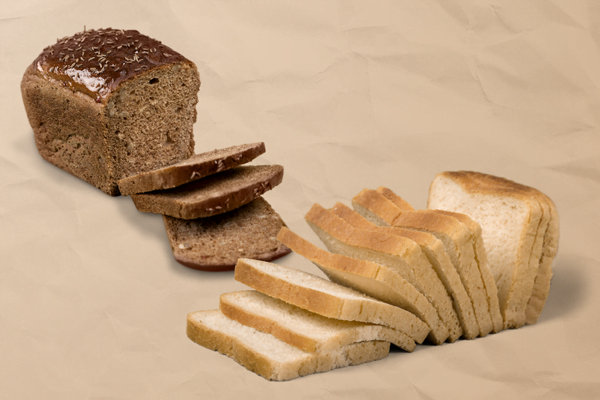Who doesn’t love bread? It is a breakfast staple, a sandwich saviour and a toasty treat. But the age-old debate on brown and white bread is often brought up when choosing. Both the breads have distinct characteristics, flavour and taste. But what sets them apart? Is it the colour difference or the ingredients? Are they nutritionally different? Or is there something else that we need to look out for?
We all know that white bread is made of refined flour, which is low in fibre and other nutrients during the processing of grains. Wheat bread is made with wheat flour and it has a good amount of fibre as the kernel is not removed in the processing.
Let us look into the nutritional content of each.
White bread vs brown bread
White bread
It is made with refined wheat flour commonly known as maida or all-purpose flour. It has a soft fluffy texture due to the elastic property of the dough. It is high in carbohydrates and has some vitamins and minerals. It is better to mix it with fibre and protein to reduce the glycaemic index and also it is balanced.
Wheat bread
Wheat bread has a dense and chewy texture and it is made with whole wheat flour. It has a dark to light brown colour depending on the quality of the wheat. It has all the parts of the kernel so it is high in fibre, vitamins and minerals, this helps you feel satiated and aids in digestion. Adding vegetables and protein to brown bread makes it more balanced and helps reduce blood sugar levels.
Glycaemic index
The measure of how fast the blood sugar rises after consuming a carbohydrate-rich meal is called glycaemic index (GI). The GI of both white and brown bread is identical, they both cause the blood sugar level to rise and also increase the LDL cholesterol (also known as bad cholesterol).
To reduce the glycaemic index of the bread it can be prepared with vegetables, paneer, eggs, and sauces. A study showed different cooking methods like freezing and defrosting, toasting from fresh and toasting following freezing and defrosting had an impact on the glycaemic index of the white bread.
Both the bread contain gluten and it can cause allergic reactions in individuals who have gluten sensitivity. The presence of phytic acid in wheat bread might prevent the absorption of minerals.
Ingredients
White bread (Modern)
Maida (refined wheat flour), sugar, yeast, iodised salt, edible vegetable fat, gluten, soya flour, preservatives (282, 200), emulsifier (471), acidity regulatory (260, 297), flour treatment agent (510) and antioxidant (300)*
Nutritional value (100g)
| Energy | 255 kcal |
| Protein | 7.7g |
| Carbohydrates | 51g |
| Total Sugar | 3.58g |
| Added sugar | 3.2g |
| Total fat | 2.3g |
White bread (Britannia)
Refined wheat flour (maida), water, sugar, yeast, iodised salt, refined palm oil, soya flour, vital gluten, preservatives (282), flour treatment agent (516 and 510), emulsifier (472e), stabiliser [170(i), 412], acidity regulator (260), vitamins and antioxidant (300)*.
Nutritional value (55g or 2 slices)
| Energy | 254 kcal |
| Protein | 7.4g |
| Carbohydrates | 52.6g |
| Total Sugar | 2.4g |
| Added sugar | 2.4g |
| Total fat | 1.5 g |
| Sodium | 452mg |
Wheat bread (Modern)
Whole wheat flour (atta 57.3%), sugar, yeast, gluten, iodised salt, edible vegetable oil (refined palmolein oil), milk solids, oat flour, soy flour, preservatives (282, 200), malt product, emulsifier (471), acidity regulators [341(i), 260, 297], flour treatment agent (510) and antioxidant (300)*.
Nutritional value (100g)
| Energy | 235kcal |
| Protein | 9.6g |
| Carbohydrates | 4.7g |
| Total Sugar | 3.9g |
| Added sugar | 3.66g |
| Total fat | 2.39g |
| Saturated fat | 1.33g |
| Sodium | 480mg |
Wheat bread (Britannia)
Wheat flour (atta 32%), refined wheat flour (maida), yeast, sugar, vital gluten, iodised salt, refined palmolein, preservative (282), emulsifiers (472e), improvers [1100(i)], acidity regulator (260), vitamins, flour treatment agent (510)*
Nutritional value (100g)
| Energy | 252 kcal |
| Protein | 8.4g |
| Carbohydrates | 51g |
| Sugar | 1.9g |
| Total fat | 1.6g |
*These numbers are E numbers. Each number is a code used for food emulsifiers, acidifiers, preservatives and additives.
These are popular brands in India. Comparing the ingredients and nutritional value shows that there is not much difference in both. There are more brands available in the market that might have slight variations in the ingredients and nutritional value. (disclaimer: not sponsoring or endorsing any brands)
Chemicals and additives
There is this belief that brown bread is better than white bread but is this true?
Although brown bread is made with whole wheat flour, in many bread-making companies to increase the production of bread, refined flour, soy flour oats flour are added along with brown bread and also to attract many consumers and to make brown bread more appealing colourant caramel colour is added in the process and many preservatives are added to increase the shelf life of the bread. In whole wheat bread, wheat flour is only approximately 52%.
A chemical additive that is commonly used in the food industry is potassium bromate. In bread, it is used for enhancing the strength of the dough and texture of the bread.
A test result conducted by the Food and Drug Administration found that the levels of potassium bromate were exceeding the maximum level. Many in the baking industry experience symptoms like painful eyes, cough, sore throat and diarrhoea. Chronic exposure to potassium bromate can increase the risk of cancer.
Another chemical commonly used in bread is potassium iodate. It strengthens and oxidises the protein bonds immediately after mixing. It also speeds up the process of leavening the bread. In the UK, EU, Australia and New Zealand the use of potassium iodate is not recommended to be used as a flour treatment.
Which bread is good?
Whole grains and multigrain are good for human consumption. But when it is processed it loses all the essential nutrients. The addition of additives, colourants and preservatives makes it not fit for human consumption when consumed for a long time.
To find a bread that is good for consumption you can look at the label. The label should say whole grain and not multigrain, you should opt for bread that says whole wheat instead of wheat flour. The fibre content of the bread should at least be 3g per serving, 3g of fibre means the kernels used for the bread were used without any processing of the grains.
It doesn’t matter if we eat brown bread or white bread because they both equally contain preservatives, colourants and other additives in them. You can have bread along with vegetables, protein and sauces to make it balanced. Also choosing a good quality bread is important, it can be white bread or brown bread.
Bread consumption can be healthy when making the correct choice. You can choose high-quality bread with little to no preservatives and colourants added. You can also bake bread at home and consume it immediately. You can add whole grains, quinoa, buckwheat, oats, seeds and nuts to make it healthy while baking bread at home.
Kripa N,
Senior Clinical Dietitian, Simplyweight





